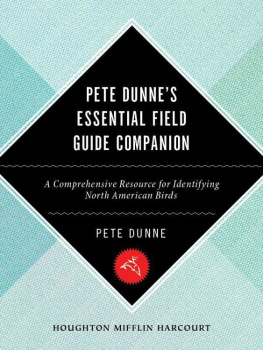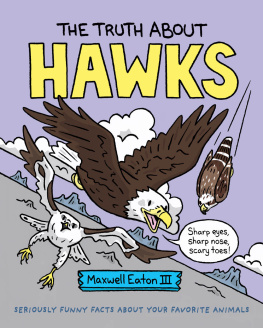
The Gray Ghost. Among frequently seen hawks, perhaps no other raptor commands the esteem among hawk watchers as the adult male Northern Harrier. JL
HAWKS IN FLIGHT
SECOND EDITION
The Flight Identification
of North American Raptors
Pete Dunne, David Sibley, and Clay Sutton


Houghton Mifflin Harcourt Company
Boston New York 2012
Text copyright 2012 by Pete Dunne, David Allen Sibley, and Clay Sutton Illustrations copyright 2012 by David Allen Sibley
All rights reserved.
For information about permission to reproduce selections from this book, write to Permissions, Houghton Mifflin Harcourt Company, 215 Park Avenue South, New York, New York 10003.
www.hmhbooks.com
Library of Congress Cataloging-in-Publication Data is available.
ISBN 978-0-395-70959-7
eISBN 978-0-547-90606-5
v1.0514
To Linda and Joan and Pat

The Prairie Wraith. There are many reasons to watch hawks in the American West, and the fleet Prairie Falcon is one of the best. JL
Acknowledgments
I f the authors were indebted to hundreds of friends, colleagues, and fellow hawk watchers for their contributions to the first edition of this book, that number must now range in the thousands. Raptor identification is a challenge that has brought a host of keen minds to bear. In honesty and in fairness, all individuals who find parts of their identity in the label hawk watcher deserve recognition in these pages because all have made their special contribution.
There are, however, some individuals whose contributions to this work deserve special recognition, starting with those whose counsel figured so prominently in that first edition of Hawks in Flight. They are: Harold Axtel, Pete Bacinski, Seth Benz, Rick Blom, Pete Both, Jim Brett, Bill Clark, Harry Darrow, Bob Dittrick, Gladys Donohue, Jim Dowdell, Howard Drinkwater, Mary Jane Evans, Fred Hamer, Greg Hanisek, Michael Heller, Steve Hoffman, Paul Kerlinger, Harry LeGrand, Arnie Moorhouse, Al Nicholson, Frank Nicoletti, Sam Orr, Roger Tory Peterson, Richard Porter, Steve Potts, Noble Proctor, Chandler Robbins, Jim Ruos, Will Russell, Fred Sibley, Gerry Smith, Ted Swem, Fred Tilly, Hal Wierenga, and Floyd Wolfarth. Most of these individuals still enjoy what are, for the most part, ventral views of hawks. A few, owing to a change in watch sites, are now specializing in dorsal views. All enjoy our thanks and appreciation.
This second edition was aided by the helpful suggestions of several individuals, most notably William S. Clark, whose critique of our first work was the basis for changes relating to description and terminology.
The assistance of three individuals, in particular, figures prominently in this book. These individuals are Jerry Liguori, Frank Nicoletti, and Allen Fish, director of the Golden Gate Raptor Observatory in San Francisco. All gave freely of their time and their considerable expertise at the onset of this project. In deference to their contribution, when referring to this book please add their names to ours. Hawks in Flight by Dunne, Sibley, and Sutton (and Fish, Liguori, and Nicoletti).
Other individuals offered their counsel and wisdom both before and during the writing of this book. They include Jorge Montejo Diaz, Miriam Moore, John Schmidt, Sheri Williamson, Tom Wood, Laurie Goodrich, Louise Zemaitis, Michael OBrien, Charles Duncan, Jeff Bouton, Jeff Dodge, Sandy Sherman, Fred Mears, Joel Simon, and Julio Gallardo.
While working on the manuscript, we found Jerry Liguoris Hawks from Every Angle, Brian K. Wheeler and William S. Clarks A Photographic Guide to North American Raptors, and Wheelers Raptors of Eastern North America and Raptors of Western North America immensely helpful. Other resources include pertinent species accounts in the Birds of North America series, and a wonderfully crafted, privately published guide to the raptors of southern Texas written and illustrated by the late Gladys Donahue. Our hats are off to her and her pioneering efforts.
Photos for this edition were garnered from a number of very fine photographers, and their inclusion in these pages greatly enhances this book, as you are destined to discover. Principal photographers were Jerry Liguori, Ned Harris, Kevin T. Karlson, and Clay Sutton. William S. Clark, Don Freiday, Tom Johnson, Tony Leukering, Jim Lish, Michael OBrien, Luke Ormond, Linda Dunne, Ted Swem, and Merrill Cottrell provided key images that ably filled many crucial gaps.
Kevin Karlson and Pat Sutton were particularly helpful in the gathering and processing of images.
This revision has been a protracted affair, tabled and picked up multiple times as the authors dealt with assorted other writing projects. We owe a debt of thanks to our editor, Lisa White, who demonstrated uncommon patience (not to mention faith); and to our agent, Russ Galen, whose unwavering encouragement was equaled only by his diplomatic skill.
Finally, and almost without saying, the authors affirm their individual and collective gratitude to the three individuals whose patience, indulgence, and support are the very foundation of all we do. Their names are Linda Dunne, Joan Walsh, and Pat Sutton, and they are, to our great fortune and their periodic despair, related to the authors by marriage.
Thank you for everything. Sorry about the lost weekends. We promise not to tackle another edition for at least a decade. Probably two.

The Black Warrior. John James Audubon may have officially named it the Harlans Hawk, but his praise for the bird is best evident in his sobriquet. JL
Introduction
S ome 24 years and 48 migratory periods have passed since the publication of Hawks in Flighta book intended to impart to readers the information and skills needed to identify distant birds of prey. To our astonishment, more than 60,000 copies of that first edition were purchased by both ardent and incipient hawk watchers. Authors and publishers could hardly ask for more.
Readers are different. Almost before the ink had dried on the pages, hawk watchers were clamoring for an edition of Hawks in Flight that would include those species not covered in the first editionraptors that have limited distributions in North America and whose seasonal redistributions are limited; raptors that we, the authors, chose not to include among 23 species of hawks that enjoy widespread distribution and migrate great distances.
Yes, readers understood our rationale, appreciating the fact that reducing variables is one of the fundamental tenets of hawk craft. But they, and finally we, understood that, in our efforts to serve probability, we had shortchanged hawk watchers in the higher currency of possibility and failed to serve those living in or visiting raptor-rich southern and border regions.




















